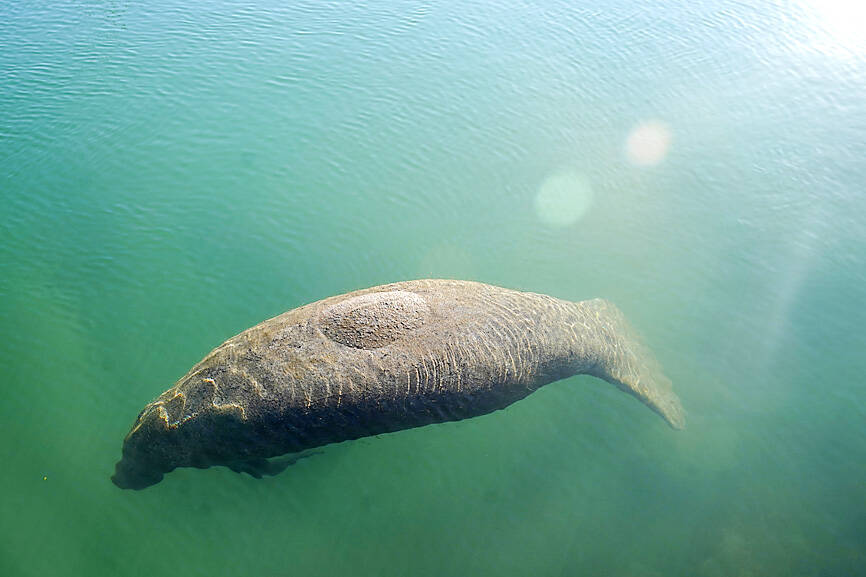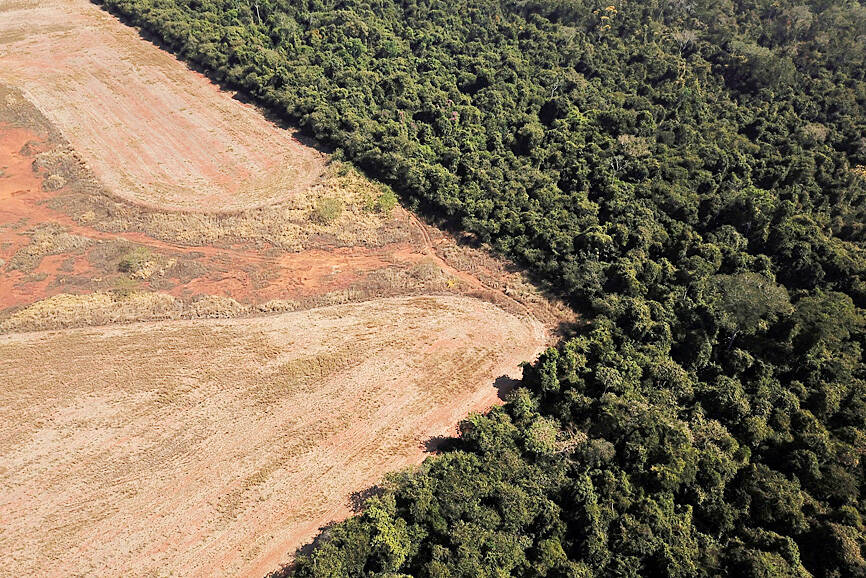In the rivers of the Peruvian Amazon, manatees wallow in the murky water, making them very hard to spot.
If you are lucky, you might see their nostrils poking out above the surface, British ecologist Kat Bruce said.
A few years ago, she joined conservationists from the WWF who were traveling a 1,000-km stretch of river to study manatees and other species.

Photo: AP
“You basically can’t survey them apart from by going to communities and asking if they’ve seen any manatees recently,” said Bruce, who in 2014 set up a monitoring company called NatureMetrics Ltd.
However, the aim of this trip was not a rare sighting. Instead, the researchers were taking water samples.
NatureMetrics pushes the water through a filter to collect traces of DNA, which are analyzed in a lab to understand which species are active in the area — in the water and on nearby land.

Photo: Reuters
In Peru, they found 675 vertebrate species — from manatees and river dolphins to night monkeys living high in the trees.
As countries negotiate a global pact to halt and reverse nature loss at the COP15 summit in Montreal this month, researchers and companies such as NatureMetrics hope their new technologies can help track progress on protecting biodiversity more accurately than ever before.
They are in a race against time, as up to 1 million of Earth’s estimated 8 million plant, insect and animal species are at risk of extinction, many within decades, an international scientific report showed in 2019.
On Friday, the International Union for Conservation of Nature (IUCN) released an update to its Red List of endangered species, flagging a “barrage of threats” affecting marine wildlife, including illegal fishing, pollution and climate change.
While success in curbing global warming can be measured in terms of reductions in planet-heating greenhouse gas emissions, understanding what advances in biodiversity protection mean for governments and companies tends to be more complex.
“You can’t actually measure ecosystem health just by monitoring what you can see,” NatureMetrics CEO Katie Critchlow said.
Using environmental DNA, or “eDNA”, NatureMetrics says it can gather more biodiversity data far faster than traditional surveys, including the presence of IUCN Red List species.
This can be tracked by small DNA filters. Water from an ecosystem is pushed by a syringe through the small discs, which are then sent to specialist labs in the UK and Canada, much like DNA tests to find out people’s ancestry.
NatureMetrics, which has grown to more than 140 employees, serves non-governmental organizations (NGOs) and companies that are looking to monitor progress in restoring a degraded ecosystem or measure whether development projects such as mining are causing harm.
“All of a sudden, now you can know whether things are getting better or not — and that’s just not been possible before,” Critchlow said. “We feel that this is quite revolutionary.”
The eDNA method is just one of a number of innovative new techniques, said Karl Burkart, co-founder and deputy director of US-based nonprofit One Earth, which is working to scale up biodiversity mapping technologies.
“In the next three to five years, we’re going to have a lot of breakthroughs in direct observation measuring,” he said.
For example, tiny cameras have been trained with artificial intelligence to collect and interpret what they capture in the field, such as detecting humans and animal species.
TrailGuard AI, created by the NGO Resolve and chipmaker Intel Corp, is developing this technology to create an alert system against animal poachers in Africa.
Another approach is acoustic sensors, which can monitor sounds from species such as birds and even insects, and is an “incredibly effective” way of determining the overall health of an ecosystem, Burkart said.
Some forests might look good from satellite images, but inside, their biodiversity can be severely degraded, a phenomenon known as “zombie forests,” he said. “It looks good from space, and inside it’s deathly silent.”
Burkart added that a “mesh” of these techniques together with remote sensing technology, deployed on planes and satellites, can provide a fuller picture of an ecosystem and how its complex parts interact.
One leader in remote sensing technologies is Arizona State University, whose scientists have created a method called “spectranomics,” whereby images taken from the air can show the complexity of species.
Used across the Andes and Amazon regions, advanced sensors can detect the unique chemical signatures of tree species based on how they interact with sunlight and illustrate the results in colorful maps.
Greg Asner, director of the school’s Center for Global Discovery and Conservation Science, said the approach, which he codeveloped, can help improve protection of tropical forests beyond broad strategic plans.
“Monitoring changes to the composition of those forests helps us to inject specific actions to save what is most unique, or what is different in one forest from another,” he said.
As these solutions begin to make their way from scientific papers to equipment used on the front lines of the natural world, investors are taking biodiversity more seriously — and could help expand the techniques for use by businesses, Burkart said.
A World Economic Forum report in 2020 showed that more than half of the world’s total GDP is dependent on nature and its services, meaning that nature loss poses a significant risk to global economic health.

Hon Hai Precision Industry Co (鴻海精密) yesterday said that its research institute has launched its first advanced artificial intelligence (AI) large language model (LLM) using traditional Chinese, with technology assistance from Nvidia Corp. Hon Hai, also known as Foxconn Technology Group (富士康科技集團), said the LLM, FoxBrain, is expected to improve its data analysis capabilities for smart manufacturing, and electric vehicle and smart city development. An LLM is a type of AI trained on vast amounts of text data and uses deep learning techniques, particularly neural networks, to process and generate language. They are essential for building and improving AI-powered servers. Nvidia provided assistance

GREAT SUCCESS: Republican Senator Todd Young expressed surprise at Trump’s comments and said he expects the administration to keep the program running US lawmakers who helped secure billions of dollars in subsidies for domestic semiconductor manufacturing rejected US President Donald Trump’s call to revoke the 2022 CHIPS and Science Act, signaling that any repeal effort in the US Congress would fall short. US Senate Minority Leader Chuck Schumer, who negotiated the law, on Wednesday said that Trump’s demand would fail, while a top Republican proponent, US Senator Todd Young, expressed surprise at the president’s comments and said he expects the administration to keep the program running. The CHIPS Act is “essential for America leading the world in tech, leading the world in AI [artificial

DOMESTIC SUPPLY: The probe comes as Donald Trump has called for the repeal of the US$52.7 billion CHIPS and Science Act, which the US Congress passed in 2022 The Office of the US Trade Representative is to hold a hearing tomorrow into older Chinese-made “legacy” semiconductors that could heap more US tariffs on chips from China that power everyday goods from cars to washing machines to telecoms equipment. The probe, which began during former US president Joe Biden’s tenure in December last year, aims to protect US and other semiconductor producers from China’s massive state-driven buildup of domestic chip supply. A 50 percent US tariff on Chinese semiconductors began on Jan. 1. Legacy chips use older manufacturing processes introduced more than a decade ago and are often far simpler than

Gasoline and diesel prices this week are to decrease NT$0.5 and NT$1 per liter respectively as international crude prices continued to fall last week, CPC Corp, Taiwan (CPC, 台灣中油) and Formosa Petrochemical Corp (台塑石化) said yesterday. Effective today, gasoline prices at CPC and Formosa stations are to decrease to NT$29.2, NT$30.7 and NT$32.7 per liter for 92, 95 and 98-octane unleaded gasoline respectively, while premium diesel is to cost NT$27.9 per liter at CPC stations and NT$27.7 at Formosa pumps, the companies said in separate statements. Global crude oil prices dropped last week after the eight OPEC+ members said they would